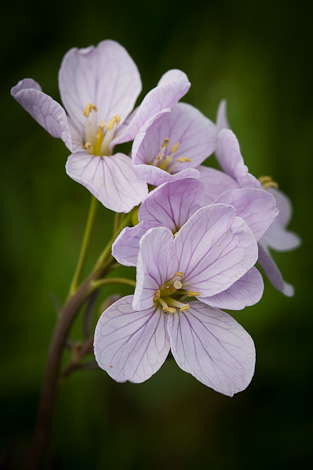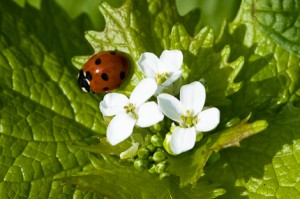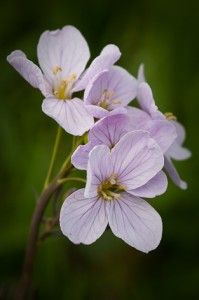 From April through to June you might see masses of white flowers in the churchyard, along hedgerows or in damp meadows (there are usually lots at the bottom of the dam in Daventry Country Park). If you get closer you will see that these are not white flowers, but very pale pink or lilac. These are cuckoo flowers or lady’s smock (they are also called milk maids, bittercress, mayflower, meadowcress and pigeon’s eye in various parts of the country). Their name originates from the coincidence of their flowering time with the call of the first returning cuckoos from their African wintering grounds. The name lady’s smock dates from the Tudor period due to the resemblance of the flowers to the smocks worn at the time. Possibly originating from this time is also the belief that it is unlucky to bring a cuckoo flower into the house.
From April through to June you might see masses of white flowers in the churchyard, along hedgerows or in damp meadows (there are usually lots at the bottom of the dam in Daventry Country Park). If you get closer you will see that these are not white flowers, but very pale pink or lilac. These are cuckoo flowers or lady’s smock (they are also called milk maids, bittercress, mayflower, meadowcress and pigeon’s eye in various parts of the country). Their name originates from the coincidence of their flowering time with the call of the first returning cuckoos from their African wintering grounds. The name lady’s smock dates from the Tudor period due to the resemblance of the flowers to the smocks worn at the time. Possibly originating from this time is also the belief that it is unlucky to bring a cuckoo flower into the house.
These are a perennial, native plant with yellow-centred flowers (which close up at night and in heavy rain) held on thin stalks that are usually about a foot in height (although they can grow to twice that height). Their small kidney-shaped leaves are rich in Vitamin C and were used to fight against scurvy. Although it has been used in salads when lettuce was not available, it hasn’t gained the popularity in modern times of its close relative, watercress.
It is however much prized by the caterpillars of both the orange tip and green veined white butterflies. In fact, one of the easiest ways to see the orange tip butterflies is to find a hedgerow containing cuckoo flowers and, if it is a sunny day, it probably won’t be long before you see a male orange tip butterfly patrolling by.
 Another plant that is seen in hedgerows alongside the cuckoo flower is garlic mustard. Like most flowers this one also has numerous other names, the most common being jack-by-the-hedge, although it is also known as Garlic Root, Hedge Garlic, Sauce-alone, Jack-in-the-bush, Penny Hedge and Poor Man’s Mustard.
Another plant that is seen in hedgerows alongside the cuckoo flower is garlic mustard. Like most flowers this one also has numerous other names, the most common being jack-by-the-hedge, although it is also known as Garlic Root, Hedge Garlic, Sauce-alone, Jack-in-the-bush, Penny Hedge and Poor Man’s Mustard.
This is a much taller, more erect plant than the cuckoo flower growing up to about a metre in height. In the first year there are rosettes of green leaves close to the ground. These overwinter and throw up strong, tall stems. Between April and June there are clusters of small white flowers, each with four petals arranged in a cross shape. These then form seed pods which are about four centimetres long that burst open in mid July scattering shiny black seeds up to a metre around.
The name derives from the smell of garlic when the leaves are bruised and, like the cuckoo flower its leaves (and sometimes flowers and seeds) have been added to salads. In this case they are said to taste of both garlic and mustard.
It has also been used medicinally as a diuretic, disinfectant and to treat gangrene, ulcers and sore throats.
It was introduced to North America in the 1860s and is now considered and invasive species (depending on conditions it can self pollinate and the seeds can lay dormant for a couple of years). In some areas it is threatening native butterflies which confuse it with food plant of their caterpillar. They then lay their eggs on the garlic mustard, but the caterpillars cannot eat the leaves and therefore don’t survive.
In the UK it is an important food plant for the caterpillars of the orange-tip and green-veined white butterflies, as well as supporting many other native insects. Its seeds are also important in the diet of farmland birds.
